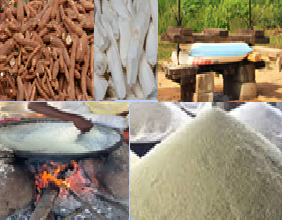How To Prepare Tubaani, a Local Food in Ghana (West Africa), and the Scientific Principles Involved

How To Prepare Tubaani, a Local Food in Ghana (West Africa), and the Scientific Principles Involved.
Tubaani (steamed black-eyed peas) is a popular street food in Ghana made from beans and spices.
It is a local food common in the northern part of Ghana.
It is a very healthy meal that is high in protein.
It is a type of bean cake cooked by steaming and is often served with spicy pepper sauce or other condiments.
The steps in preparing tubaani are:
Soaking the Beans
- Soak 3 cups of black-eyed peas or cowpeas in water overnight.
- This will help to soften the beans and reduce the cooking time.
- It also helps to save fuel; thus, it can be either charcoal, firewood, electricity, or gas.
Preparing the Batter
- Drain the soaked beans and transfer them to a blender or food processor.
- Add 2 medium-sized onions, 3-6 cloves of garlic, 2-4 fresh chilli peppers, and a pinch of salt.
- Blend or grind the mixture until it forms a smooth batter.
- You can add a little water if needed to achieve the desired consistency.
Fermentation
- Transfer the batter to a large bowl and cover it loosely with a clean cloth or plastic wrap.
- Allow the batter to ferment for about 9 to 12 hours at room temperature.
- This fermentation process helps to enhance the flavour and texture of the tubaani.
Prepare the Setup for Steaming or cooking
- While the batter is fermenting, set up the steaming apparatus.
- You can use a large pot with a steamer basket or a specialised steamer.
- Fill the pot with water, making sure it does not touch the bottom of the steamer basket or the tubaani mixture.
Forming the Tubaani
- After the fermentation period, stir the batter gently to incorporate any settled sediments or to achieve a uniform mixture
- Take a clean banana leaf or aluminium foil and cut it into squares or rectangles (about 3 to 6 inches).
- Spoon a portion of the batter onto each leaf or foil, shaping it into a small ball, oblong shape or your preferred shape.
Steaming the Tubaani
- Carefully place the formed tubaani onto the steamer basket, making sure they are not crowded to allow even cooking.
- Cover the pot with a lid and steam the tubaani for approximately reasonable hours, or until they are firm and cooked through.
Ready for Enjoyment
- Once cooked, remove the tubaani from the steamer and let them cool slightly.
- Unwrap the banana leaves or foil and serve the tubaani warm or at room temperature
Tubaani is often enjoyed as a snack or a breakfast dish in Ghana, especially in the northern part, and it pairs well with a spicy pepper sauce.
Science Principles Involved in Tubaani Making
Soaking:
- Soaking the beans promotes microbial growth, particularly lactic acid bacteria and yeast, which are pivotal for subsequent fermentation.
- Enzymatic activity breaks down complex carbohydrates and proteins, improving digestibility and flavour.
Grinding:
- The cooled peanuts are ground into a fine paste using a grinding machine or a traditional mortar and pestle.
Fermentation:
- Fermentation is a key step in tubaani production, where microorganisms metabolise sugars and produce organic acids and gases.
- This process softens the beans, enhances flavour and improves digestibility.
Wrapping and Steaming:
- Fresh leaves like banana leaves or plantain leaves are used to wrap the Tubaani before the steaming process.
- The leaves are cleaned and dried before wrapping.
Cooling and Serving:
- Physics principles of heat transfer and thermodynamics govern the cooling process, as heat dissipates from the hot tubaani to the surrounding environment, reducing its temperature to a palatable level.







